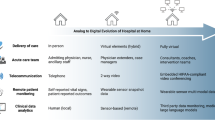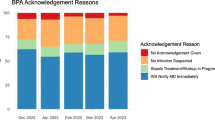Abstract
Background
Extrauterine growth restriction from inadequate nutrition remains a significant morbidity in very low birth weight infants. Participants in the California Perinatal Quality Care Collaborative Quality Improvement Collaborative, Grow, Babies, Grow! developed or refined tools to improve nutrition and reduce practice variation.
Method
Five Neonatal Intensive Care Units describe the development and implementation of nutrition tools. Tools include Parenteral Nutrition Guidelines, Automated Feeding Protocol, electronic medical record Order Set, Nutrition Time-Out Rounding Tool, and a Discharge Nutrition Recommendations. 15 of 22 participant sites completed a survey regarding tool value and implementation.
Results
Reduced growth failure at discharge was observed in four of five NICUs, 11–32% improvement. Tools assisted with earlier TPN initiation (8 h) and reaching full feeds (2–5 days). TPN support decreased by 5 days. 80% of survey respondents rated the tools as valuable.
Conclusion
Evidence and consensus-based nutrition tools help promote standardization, leading to improved and sustainable outcomes.
This is a preview of subscription content, access via your institution
Access options
Subscribe to this journal
Receive 12 print issues and online access
$259.00 per year
only $21.58 per issue
Buy this article
- Purchase on Springer Link
- Instant access to full article PDF
Prices may be subject to local taxes which are calculated during checkout





Similar content being viewed by others
References
Goldberg DL, Becker PJ, Brigham K, Carlson S, Fleck L, Gollins L, et al. Identifying Malnutrition in Preterm and Neonatal Populations: Recommended Indicators. J Acad Nutr Dietetics. 2018;118:1571–82.
Horbar JD, Ehrenkranz RA, Badger GJ, Edwards EM, Morrow KA, Soll RF, et al. Weight Growth Velocity and Postnatal Growth Failure in Infants 501 to 1500 Grams: 2000–2013. Pediatrics. 2015;136:e84–92.
Thiess T, Lauer T, Woesler A, Neusius J, Stehle S, Zimmer KP, et al. Correlation of Early Nutritional Supply and Development of Bronchopulmonary Dysplasia in Preterm Infants <1,000 g. Front Pediatr. 2021;9:741365.
Makker K, Ji Y, Hong X, Wang X. Antenatal and neonatal factors contributing to extra uterine growth failure (EUGR) among preterm infants in Boston Birth Cohort (BBC). J Perinatol. 2021;41:1025–32.
Martínez-Jiménez MD, Gómez-García FJ, Gil-Campos M, Pérez-Navero JL. Comorbidities in childhood associated with extrauterine growth restriction in preterm infants: a scoping review. Eur J Pediatr. 2020;179:1255–65.
Wight, N, Kim, J, Rhine, W, Mayer, O, Morris, M, Sey, R, et al. Nutritional Support of the Very Low Birth Weight (VLBW) Infant: A Quality Improvement Toolkit Available from: https://www.cpqcc.org (2018).
Ruys CA, van de Lagemaat M, Rotteveel J, Finken MJJ, Lafeber HN. Improving long-term health outcomes of preterm infants: how to implement the findings of nutritional intervention studies into daily clinical practice. Eur J Pediatr. 2021;180:1665–73.
Young A, Beattie RM, Johnson MJ. Optimising growth in very preterm infants: reviewing the evidence. Arch Dis Child Fetal Neonatal Ed. 2023;108:2–9.
Horbar JD, Plsek PE, Leahy K. NIC/Q 2000: Establishing Habits for Improvement in Neonatal Intensive Care Units. Pediatrics. 2003;111:e397–410.
Adams M, Bassler D, Bucher HU, Roth-Kleiner M, Berger TM, Braun J, et al. Variability of Very Low Birth Weight Infant Outcome and Practice in Swiss and US Neonatal Units. Pediatrics. 2018;141:e20173436.
Stevens T, Shields E, Campbell D, Combs A, Horgan M, La Gamma E, et al. Variation in Enteral Feeding Practices and Growth Outcomes among Very Premature Infants: A Report from the New York State Perinatal Quality Collaborative. Am J Perinatol. 2015;33:009–19.
McLeod G, Farrent S, Gilroy M, Page D, Oliver CJ, Richmond F, et al. Variation in Neonatal Nutrition Practice and Implications: A Survey of Australia and New Zealand Neonatal Units. Front Nutr. 2021;8:642474.
Kaplan HC, Edwards EM, Soll RF, Morrow KA, Meyers J, Timpson W, et al. Variability in the systems of care supporting critical neonatal intensive care unit transitions. J Perinatol. 2020;40:1546–53.
McCormick K, King C, Clarke S, Jarvis C, Johnson M, Parretti HM, et al. The role of breast milk fortifier in the post-discharge nutrition of preterm infants. Br J Hosp Med. 2021;82:42–8.
Kaplan HC, Poindexter BB. Standardized Feeding Protocols: Evidence and Implementation. In: Koletzko B, Cheah FC, Domellöf M, Poindexter BB, Vain N, van Goudoever JB, editors. World Review of Nutrition and Dietetics. S. Karger AG; 2021. 289–300. Available from: https://www.karger.com/Article/FullText/514746.
Stevens TP, Shields E, Campbell D, Combs A, Horgan M, La Gamma EF, et al. Statewide Initiative to Reduce Postnatal Growth Restriction among Infants <31 Weeks of Gestation. J Pediatrics. 2018;197:82–89.e2.
Dhanireddy R, Scott PA, Barker B, Scott TA. Quality Initiative to Reduce Extrauterine Growth Restriction in Very Low Birth Weight Infants. Hospital Pediatrics. 2022;12:173–81.
Lagerquist E, al‐Haddad BJS, Irvine J, Muskthel L, Rios A, Upadhyay K. Feeding volume advancement in preterm neonates: A level 4 neonatal intensive care unit quality improvement initiative. Nut in Clin Prac. 2023;38:1175–80.
The Breakthrough Series: IHI’s Collaborative Model for Achieving Breakthrough Improvement. IHI Innovation Series white paper. Boston: Institute for Healthcare Improvement; 2003. Available from: https://www.ihi.org/resources/Pages/IHIWhitePapers/TheBreakthroughSeriesIHIsCollaborativeModelforAchievingBreakthroughImprovement.aspx.
Groh-Wargo S, Barr SM. Parenteral Nutrition. Clin Perinatol. 2022;49:355–79.
Sniderman S, Hetherton M. Fluids and Electrolytes and Parenteral Nutrition. In The William H. Tooley Intensive Care Nursery House Staff Manual, 8th edition. San Francisco: University of California; 2003.
Street JL, Montgomery D, Alder SC, Lambert DK, Gerstmann DR, Christensen RD. Implementing feeding guidelines for NICU patients<2000 g results in less variability in nutrition outcomes. JPEN J Parenter Enter Nutr. 2006;30:515–8.
Jasani B, Patole S. Standardized feeding regimen for reducing necrotizing enterocolitis in preterm infants: an updated systematic review. J Perinatol. 2017;37:827–33.
Parker LA, Desorcy-Scherer K, Magalhães M. Feeding Strategies in Preterm Very Low Birth-Weight Infants: State-of-the-Science Review. Adv Neonatal Care. 2021;21:493–502.
McKinley LT, Przystac L, Tucker R, Trail-Burns E, Vohr BR, Laptook AR, et al. Implementation of a Nutrition Care Bundle and Improved Weight Gain of Extremely Preterm Infants to 36 Weeks Postmenstrual Age. J Pediatrics. 2022;241:42–47.e2.
Abiramalatha T, Thanigainathan S, Ramaswamy VV, Rajaiah B, Ramakrishnan S, Cochrane Neonatal Group. Routine monitoring of gastric residual for prevention of necrotising enterocolitis in preterm infants. Cochrane Database Syst Rev. 2023. Available from: https://doi.org/10.1002/14651858.CD012937.pub3.
Hale G, McNab D. Developing a ward round checklist to improve patient safety. BMJ Qual Improv Rep. 2015;4:u204775.w2440.
McConnell RA, Kerlin MP, Schweickert WD, Ahmad F, Patel MS, Fuchs BD. Using a Post-Intubation Checklist and Time Out to Expedite Mechanical Ventilation Monitoring: Observational Study of a Quality Improvement Intervention. Respir Care. 2016;61:902–12.
Barimani B, Ahangar P, Nandra R, Porter K. The WHO Surgical Safety Checklist: A Review of Outcomes and Implementation Strategies. Perioper Care Operat Room Manag. 2020;21:100117.
Taylor SN, Martin CR. Evidence-based Discharge Nutrition to Optimize Preterm Infant Outcomes. Neoreviews. 2022;23:e108–16.
Lowe J, Wong J. Primary Care for Preterm Infants & Children: A CPQCC Provider Toolkit. 2020; Available from: www.cpqcc.org.
Rozich JD, Howard RJ, Justeson JM, Macken PD, Lindsay ME, Resar RK. Standardization as a Mechanism to Improve Safety in Health Care. Jt Comm J Qual Saf. 2004;30:5–14.
Rolnitsky A, Bell CM. Sustaining Improvement Initiatives: Challenges and Potential Tools. Clin Perinatol. 2023;50:307–20.
Balasundaram M, Land R, Miller S, Profit J, Porter M, Arnold C, et al. Increasing early exposure to mother’s own milk in premature newborns. J Perinatol. 2022;42:1126–34.
Celenza JF, Zayack D, Buus-Frank ME, Horbar JD. Family Involvement in Quality Improvement. Bedside Advocate Syst Advisor Clin Perinatol 2017;44:553–66.
Acknowledgements
We would like to thank the interdisciplinary team members of the 22 California NICUs who participated in the CPQCC Grow, Babies, Grow Collaborative.
Author information
Authors and Affiliations
Contributions
MM conceived and designed the concept, designed the survey, performed data collection, and drafted and revised the manuscript. SB interpreted the results and critically reviewed and revised the manuscript. LD contributed to writing and critically reviewing the manuscript. MH contributed to writing and critically reviewing the manuscript. RK contributed to writing and reviewing the manuscript. HS contributed to writing, critically reviewing, and editing the manuscript. CB designed the survey, interpreted the results, assisted with data analysis, and reviewed the manuscript. KL contributed to writing the manuscript, interpreted the results and created the survey figures, and critically reviewed the manuscript. All authors approved the final manuscript as submitted and agree to be accountable for the work.
Corresponding author
Ethics declarations
Competing interests
The authors declare no competing interests.
Additional information
Publisher’s note Springer Nature remains neutral with regard to jurisdictional claims in published maps and institutional affiliations.
Rights and permissions
Springer Nature or its licensor (e.g. a society or other partner) holds exclusive rights to this article under a publishing agreement with the author(s) or other rightsholder(s); author self-archiving of the accepted manuscript version of this article is solely governed by the terms of such publishing agreement and applicable law.
About this article
Cite this article
Morris, M., Bennett, S., Drake, L. et al. Multidisciplinary evidence-based tools for improving consistency of care and neonatal nutrition. J Perinatol (2024). https://doi.org/10.1038/s41372-024-01963-x
Received:
Revised:
Accepted:
Published:
DOI: https://doi.org/10.1038/s41372-024-01963-x



